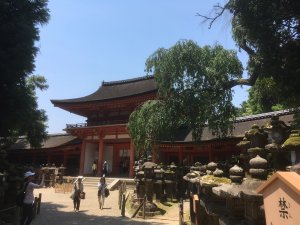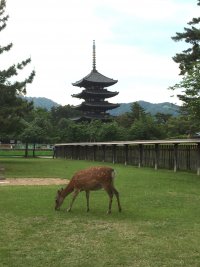Written by Kagita Chūbee, 20th sōke of the Hōzōinryū
The Kōfukuji during the Middle Ages
The Middle Ages in Japan cover the time from the second half of the Heian period1 through the Kamakura period2 and the Nanbokuchō period3 up to the Muromachi period4 and the Sengoku period5 and are characterized by the transition of power from a hereditary monarchie to the warrior class. At the same time the old feudal system which centered around the imperial central government declined due to the rise of true local rulers like the military provincial administrators6 or land stewards7.
 On top of that the great Buddhist temples and Shintō shrines like the Enryakuji and the Kōfukuji became independent military powers by employing armies of warrior monks. Often the warrior monks of the Kōfukuji drew up in large numbers in front of the imperial palace in the center of Kyōto, carrying sakaki-branches8 from the Kasuga-Taisha9 decorated with holy mirrors10 and sacred ropes11 in front of them which symbolized the will of the gods, to force the demands of the temple. If these demands were not met, they simply left the holy branches in front of the imperial palace gates, thus paralizing all political activities (due to the psychological pressure implied by the will of the gods).
On top of that the great Buddhist temples and Shintō shrines like the Enryakuji and the Kōfukuji became independent military powers by employing armies of warrior monks. Often the warrior monks of the Kōfukuji drew up in large numbers in front of the imperial palace in the center of Kyōto, carrying sakaki-branches8 from the Kasuga-Taisha9 decorated with holy mirrors10 and sacred ropes11 in front of them which symbolized the will of the gods, to force the demands of the temple. If these demands were not met, they simply left the holy branches in front of the imperial palace gates, thus paralizing all political activities (due to the psychological pressure implied by the will of the gods).
Together the Enryakuji and the Kōfukuji were called "Nanto-Hokurei12" and were so much feared that the emperor Shirakawa13 lamented the Enryakuji's attempts at extortion with the words: "There are three things I can not controll (even so I am the emperor of Japan). These are the rapids of the river Kamogawa, the fall of the dices in the game Sugoroku14 and the warrior priests from the Mountain Hiei".
The medieval Kōfukuji had controll over most of the estates in the Yamato province15. With such enormous economic backing the tempel had more than 100 sub-temples and dormitories and between 3000 and 5000 monks in its heyday. Most of the sub-temples were subordinated either to the Ichijōin or the Daijōin16. Our Hōzōin also was a sub-temple of the Kōfukuji and subordinated to the Daijōin.
 In the Heian period the Kōfukuji de facto held the rights of a feudal Lord which were exercised by the Ichijōin and the Daijōin. What made it possible for these two sub-temples to reach so high a position was the fact that the Kōfukuji had been founded by Fujiwara no Kamatari17, the ancestor of the Fujiwara clan, and his son Fujiwara no Fuhito18 and was the family temple of the Fujiwaras. Furthermore the Kōfukuji was the temple the sons of the regent-families19 (these were the families which could provide a sesshō20 or a kanpaku21) would join.
In the Heian period the Kōfukuji de facto held the rights of a feudal Lord which were exercised by the Ichijōin and the Daijōin. What made it possible for these two sub-temples to reach so high a position was the fact that the Kōfukuji had been founded by Fujiwara no Kamatari17, the ancestor of the Fujiwara clan, and his son Fujiwara no Fuhito18 and was the family temple of the Fujiwaras. Furthermore the Kōfukuji was the temple the sons of the regent-families19 (these were the families which could provide a sesshō20 or a kanpaku21) would join.
Even when the Shōgunate appointed land stewards in the Kamakura period respectively military provincial administrators in the Muromachi period for all territories the Kōfukuji continued to rule above the province of Yamato. There was no other province like this in Japan where the power of the Shōgunate didn't reach. The Kōfukuji was simply too powerfull.
Within the Kōfukuji the Ichijōin and the Daijōin which were equal to each other competed for supremacy but also worked and fought together when it was necessary. The armed monks of the temple were assigned with the protection of the temple's estates in Yamato and their inhabitants. I believe these were the social conditions which formed Hōzōin Inei, let him discover the advantages of the sickle-spear and develop original techniques with this weapon which finally lead to the foundation of his own school of spearmanship inside the Kōfukuji.
The Kōfukuji had many followers among laymen and the revenues from its vast estates enabled the temple to foster single talents as well as the culture in toto. The Kōfukji contributed a lot to the development of the arts in a time when economics, science and arts and crafts began to flower in Japan. It is not exaggerated to say that a large part of that what we call traditional Japanese culture today had its origin in medieval Nara, may it be the Nō-theater, the tea-ceremony, Ikebana, brewing techniques or the martial arts.
Under the name Heijōkyō22 Naras history reaches back 1300 years, and I constantly wonder if we shouldn't pay much more attention to its medieval culture.
(First published in the Nara town magazine Ubusuna on April 5th 2009)
1. 794 - 1185
2. 1185 - 1333
3. 1336 - 1392
4. 1392 - 1573
5. 1467 - 1568
6. Shugo
7. Jitō
8. An evergreen tree (Cleyera japonica) considered to be holy in Shintōism.
9. This Shintō shrine is located in the vicinity of the Kōfukuji. Like the Kōfukuji the Kasuga-Taisha was founded by the Fujiwara clan. Due to the shintō-buddhistic syncretism of the latter Hein period the Kōfukuji was intergrated into the Kasuga-Taisha.
10. Metal mirrors with one side polished to a mirror finish are worshiped as a symbol of a divinity in many Shintō shrines.
11. Shimenawa; these ropes mark sacred locations, trees and more.
12. Literally: the southern capital and the mountain in the north. The southern capital means Nara, which had been capital before Kyōto, and stands for the Kōfukuji. The mountain in the north ist the Hieizan in the northeast of Kyōto on which the Enryakuji is located.
13. 1053 - 1129
14. A game similar to backgammon.
15. Corresponds to modern-day's Nara prefecture.
16. The Ichijōin and the Daijōin in turn were sub-temples of the Kōfukuji.
17. 614 - 669; founder of the powerfull Fujiwara clan, bon as Nakatomi no Kamatari, organized the Isshi-incident (see also part 2).
18. 659 - 720; second son of Kamatari. He moved the family-temple of the Fujiwaras which until then had been called Yamashinadera from Kyōto to Nara renamed it Kōfukuji. In 768 Kasuga-Taisha which was the main Shintō shrine of the Fujiwara clan was moved from the mountain Mikasa to its foot into the vicinity of the Kōfukuji.
19. These were five noble houses of the Fujiwara clan, namely the Ichijō, the Konoe, the Kujō, the Nijō und the Takatsukasa.
20. A regent reigning in behalf of a Tennō under age (or a female Tennō).
21. A regent reigning in behalf of a Tennō of age.
22. Nara's old name.
